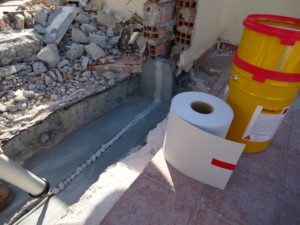
Condensation humidity
There are buildings where condensation damp can become a serious problem not only for the integrity of the building itself, but also for the health of the people living inside. For this reason, it is important to know why it occurs and, of course, the different solutions that can be applied to prevent it from continuing to develop.

What is condensation dampness and what problems does it cause?
Damp is a problem that affects a high percentage of buildings and constructions of many different types, but it is also important to understand that there are different types of damp that are classified according to the reasons why they occur.
In the case of condensation dampness, this is a problem that comes from the high level of humidity inside the house.
This humidity is in a gaseous state, but when it reaches the coldest areas such as windows, the gas cools down and becomes liquid, so that the phenomenon of wet windows is observed as if it had rained inside the house.
The problem with this dampness is that it affects not only the windows but also the walls and the building in general, as well as being hazardous to the health of those living inside.
Main causes for which it occurs
A good way to prevent condensation dampness is to understand the most common reasons why it can occur, so we will highlight some of them:
- Drying clothes indoors can cause a higher volume of moisture to accumulate.
- Various household appliances such as cookers and ovens produce high levels of humidity.
- The humidity level increases when the shower is used.
- Lack of ventilation.
- People’s own breathing produces moisture.
- Heating systems and cookers also increase indoor humidity.
Solutions to prevent moisture condensation
There are different solutions to prevent moisture due to condensation, so it is highly recommended to take them all into account in order to analyse which of them is going to be more efficient and offer better results.
Tips for reducing humidity levels
It is important that we take into account the reasons listed by vamos that favour the appearance of condensation dampness, so we can reveal these simple tricks that will significantly lower humidity levels:
- It is very important to ventilate the house properly every day.
- It is best to mow clothes outside and, if this is not possible, to dry them in a tumble dryer.
- Using a dehumidifier is a very efficient way to reduce humidity levels.
- When using the oven in the kitchen, run the extractor fan or open the windows so that the steam escapes outside instead of turning into indoor humidity.
- Use heating systems wisely and do not abuse them.
Waterproofing of walls
The waterproofing of facades and walls is one of the most efficient solutions to put an end to condensation damp.
It can be assumed that many buildings, especially older buildings that have been poorly designed, are poorly insulated, which means that condensation dampness is more likely to form than if they are properly insulated.
In this sense, it is very important to work especially on the enclosures, as they are the ones in contact with the exterior and allow exchange depending on the degree of insulation they present.
It should be borne in mind that this is a very intelligent investment, as it not only avoids the annoying damp, discomfort and stains it produces, but also helps to protect the health of those living inside the home, while increasing the safety and protection of the walls, structure and installations of the building, thus extending its useful life and avoiding damage or operational problems that can be prevented.
















